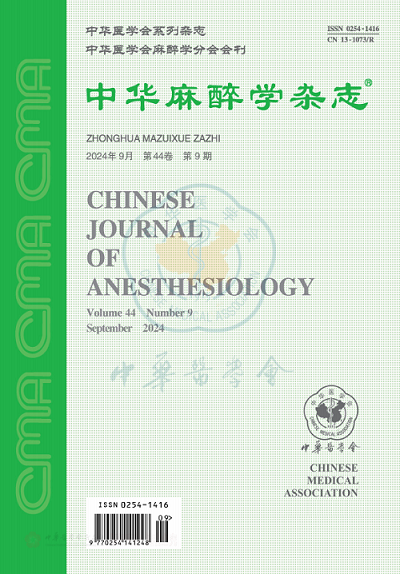Effects of dexmedetomidine on renal fibrosis in a mouse model of renal ischemia-reperfusion: the role of Akt
Q4 Medicine
引用次数: 0
Abstract
Objective To evaluate the effect of dexmedetomidine on renal fibrosis in a mouse model of renal ischemia-reperfusion (I/R) and the role of serine-threonine kinase (Akt). Methods Sixty male C57BL/6 mice, aged 8 weeks, weighing 20-25 g, were divided into 5 groups (n=12 each) using a random number table method: sham operation group (S group), renal I/R group (I/R group), renal I/R plus dexmedetomidine group (I/R + D group), renal I/R plus dexmedetomidine plus Akt agonist SC79 group (I/R + D + SC group), and renal I/R plus dexmedetomidine plus normal saline group (I/R+ D+ NS group). Renal I/R injury model was established by clamping the bilateral renal pedicle for 30 min followed by reperfusion.Dexmedetomidine was intraperitoneally injected at 30 min before surgery in I/R+ D, I/R+ D+ SC and I/R+ D+ NS groups.SC79 was intraperitoneally injected as a bolus of 0.04 mg/kg at 1 min of reperfusion, followed by an intraperitoneal injection of the same dose every 24 h until day 7.The serum blood urea nitrogen (BUN) and Scr concentrations were detected at 24 h of reperfusion.Renal tissues were taken, and the damage to the renal tubules was scored.Renal tissues were removed at 14 days of reperfusion to detect the degree of renal fibrosis and expression of collagen 1 (COL1), fibronectin (FN), and α-smooth actin (α-SMA) (by immunofluorescence and Western blot). The expression of phosphorylated Akt (p-Akt) in renal tissues was determined by Western blot at 24 h and 14 day of reperfusion. Results Compared with group S, the serum BUN and Scr concentrations, renal tubule damage score and degree of renal fibrosis were significantly increased, and the expression of COL1, FN, α-SMA and p-Akt was up-regulated in group I/R (P<0.05). Compared with I/R group, the serum BUN and Scr concentrations, renal tubular damage score and degree of renal fibrosis were significantly decreased, and the expression of COL1, FN, α-SMA and p-Akt was down-regulated in I/R+ D and I/R+ D+ NS groups (P<0.05). Compared with I/R+ D group, the serum BUN and Scr concentrations, renal tubule damage score and degree of renal fibrosis were significantly increased , and the expression of COL1, FN, α-SMA and p-Akt was up-regulated in I/R+ D+ SC group (P<0.05). Conclusion Dexmedetomidine can reduce the degree of renal fibrosis in a mouse model of renal I/R and the mechanism is related to inhibiting activation of Akt. Key words: Dexmedetomidine; Fibrosis; Kidney; Reperfusion injury; Protein-serine-threonine kinases右美托咪定对肾缺血再灌注模型小鼠肾纤维化的影响:Akt的作用
目的评价右美托咪定对小鼠肾缺血再灌注(I/R)模型肾纤维化的影响及丝氨酸-苏氨酸激酶(Akt)的作用。方法60只雄性C57BL/6小鼠,年龄8周,体重20~25g,采用随机数表法分为5组(每组12只):假手术组(S组)、肾I/R组(I/R组)、肾脏I/R加右美托咪定组(I/R+D组)、,肾I/R加右美托咪定加生理盐水组(I/R+D+NS组)。夹闭双侧肾蒂30min后再灌注,建立肾I/R损伤模型。I/R+D组、I/R+D+SC组和I/R++D+NS组术前30min腹膜内注射右美托咪定。在再灌注1分钟腹膜内注射SC79,剂量为0.04 mg/kg,然后每24小时腹膜内注射相同剂量,直到第7天。在再灌注24小时检测血清尿素氮(BUN)和Scr浓度。取肾组织,对肾小管损伤进行评分。在再灌注14天时切除肾组织,以检测肾纤维化程度以及胶原1(COL1)、纤连蛋白(FN)和α-光滑肌动蛋白(α-SMA)的表达(通过免疫荧光和蛋白质印迹)。在再灌注24小时和14天,通过蛋白质印迹测定肾组织中磷酸化Akt(p-Akt)的表达。结果与S组相比,I/R组血清BUN和Scr浓度、肾小管损伤评分和肾纤维化程度显著升高,COL1、FN、α-SMA和p-Akt表达上调(p<0.05),I/R+D组和I/R+D+NS组COL1、FN、α-SMA和p-Akt表达下降(p<0.05),I/R+D+SC组α-SMA和p-Akt表达上调(p<0.05)。关键词:右美托咪定;纤维化;肾脏;再灌注损伤;蛋白质丝氨酸-苏氨酸激酶
本文章由计算机程序翻译,如有差异,请以英文原文为准。
求助全文
约1分钟内获得全文
求助全文

 求助内容:
求助内容: 应助结果提醒方式:
应助结果提醒方式:


